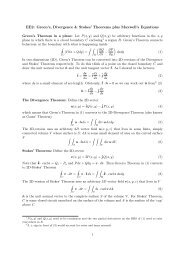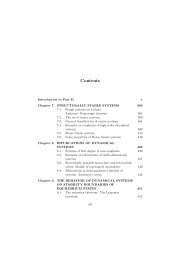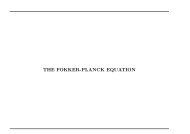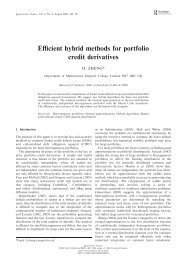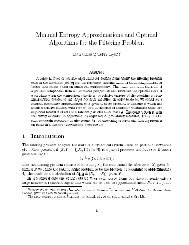14 April 2010 - Imperial College London
14 April 2010 - Imperial College London
14 April 2010 - Imperial College London
Create successful ePaper yourself
Turn your PDF publications into a flip-book with our unique Google optimized e-Paper software.
stochastics,control and finance<br />
In honour of<br />
Professor Mark H.A. Davis<br />
on the occasion of his 65th birthday<br />
<strong>Imperial</strong> <strong>College</strong> <strong>London</strong><br />
12 –<strong>14</strong> <strong>April</strong> <strong>2010</strong><br />
WORKSHOP<br />
Organising Committee<br />
Dirk Becherer (Humboldt University of Berlin)<br />
Giulia Di Nunno (University of Oslo)<br />
Mihail Zervos (<strong>London</strong> School of Economics)<br />
Harry Zheng (<strong>Imperial</strong> <strong>College</strong>)<br />
Sponsors<br />
European Science Foundation<br />
(Advanced Mathematical Methods in Finance Program)<br />
<strong>London</strong> Mathematical Society<br />
<strong>Imperial</strong> <strong>College</strong> (Department of Electrical and<br />
Electronic Engineering and Department of Mathematics)
programme
Monday, <strong>April</strong> 12<br />
08:30-09:00 Registration at Electrical<br />
Engineering Building<br />
Session 1. Chair: Mark Davis<br />
09:00-09:10 Tomas Björk (welcome)<br />
09:10-09:40 Richard Vinter<br />
09:45-10:15 Andrew Heunis<br />
10:20-10:50 Coffee Break<br />
Session 2. Chair: Alex Mijatović<br />
10:50-11.20 Martin Schweizer<br />
11:25-11:55 Ralf Korn<br />
12:00-12:30 Vicky Henderson<br />
12:35-<strong>14</strong>:00 Break<br />
Session 3. Chair: Giulia Di Nunno<br />
<strong>14</strong>:00-<strong>14</strong>:30 Xunyu Zhou<br />
<strong>14</strong>:35-15:05 Tomas Björk<br />
15:10-15:40 Coffee Break<br />
Session 4. Chair: Dirk Becherer<br />
15:40-16:10 Paul Embrechts<br />
16:15-16:45 Eduardo Epperlein<br />
16:50-17:20 Alexander Lipton<br />
Tuesday, <strong>April</strong> 13<br />
Session 1. Chair: Arne Løkka<br />
09:00-09:30 Ioannis Karatzas<br />
09:35-10:05 Michel Vellekoop<br />
10:10-10:40 Coffee Break<br />
Session 2. Chair: Martijn Pistorius<br />
10:40-11.10 Bernt Øksendal<br />
11:15-11:45 Nizar Touzi<br />
11:50-12:20 Saul Jacka<br />
12:25-<strong>14</strong>:00 Break<br />
Session 3. Chair: Dorje Brody<br />
<strong>14</strong>:00-<strong>14</strong>:30 Michael Dempster<br />
<strong>14</strong>:35-15:05 David Hobson<br />
15:10-15:40 Coffee Break<br />
Session 4. Chair: Sébastien Lleo<br />
15:40-16:10 Eckhard Platen<br />
16:15-16:45 Jim Gatheral<br />
16:50-17:20 Vladimir Lucić<br />
5<br />
Wednesday, <strong>April</strong> <strong>14</strong><br />
Session 1. Chair: Nick Bingham<br />
09:00-09:30 Terry Lyons<br />
09:35-10:05 Martin Clark<br />
10:10-10:40 Coffee Break<br />
Session 2. Chair: Michael Monoyios<br />
10:40-11.10 Thaleia Zariphopoulou<br />
11:15-11:45 Peter Bank<br />
11:50-12:20 Lane Hughston<br />
12:25-<strong>14</strong>:00 Break<br />
Session 3. Chair: Albina Danilova<br />
<strong>14</strong>:00-<strong>14</strong>:30 Walter Schachermayer<br />
<strong>14</strong>:35-15:05 Jan Ob�lój<br />
15:10-15:40 Coffee Break<br />
Session 4. Chair: Mihail Zervos<br />
15:40-16:10 Chris Rogers<br />
16:15-16:45 Mark Davis<br />
16:50-17:00 Thaleia Zariphopoulou<br />
. (conclude)
abstracts
Market indifference prices<br />
Peter Bank<br />
Technical University of Berlin<br />
We consider a financial market model where a single large investor submits orders to a finite<br />
number of market makers. These orders are filled at what we call market indifference prices<br />
and they lead to a new efficient allocation of risk among the market makers. We show<br />
how this allocation depends on the size of the order, discuss the cash compensation between<br />
market makers and the large investor, and explain how convex duality techniques allow for a<br />
quantitative analysis of the permanent market impact resulting from a transaction. (This is<br />
joint work with Dmitry Kramkov.)<br />
Time inconsistent stochastic control<br />
Tomas Björk<br />
Stockholm School of Economics<br />
We present a theory for stochastic control problems which, in various ways, are time inconsistent<br />
in the sense that they do not admit a Bellman optimality principle. We attach these<br />
problems by viewing them within a game theoretic framework, and we look for subgame<br />
perfect Nash equilibrium points.<br />
For a general controlled Markov process and a fairly general objective functional we derive an<br />
extension of the standard Hamilton-Jacobi-Bellman equation, in the form of a system of nonlinear<br />
equations, for the determination for the equilibrium strategy as well as the equilibrium<br />
value function. All known examples of time inconsistency in the literature are easily seen to<br />
be special cases of the present theory. We prove that for every time inconsistent problem,<br />
there exists an associated time consistent problem such that the optimal control and the<br />
optimal value function for the consistent problem coincides with the equilibrium control and<br />
value function respectively for the time inconsistent problem. We also study some concrete<br />
examples.<br />
Approximation of filters for homogeneous diffusions<br />
by matched Beneˇs filters<br />
Martin Clark<br />
<strong>Imperial</strong> <strong>College</strong> <strong>London</strong><br />
TBA<br />
Asset management via risk-sensitive stochastic control<br />
Mark Davis<br />
<strong>Imperial</strong> <strong>College</strong> <strong>London</strong><br />
This talk summarizes joint work with Sébastien Lleo on risk-sensitive portfolio optimization<br />
with jump-diffusion asset price processes whose growth rates depend on a factor process<br />
Xt. When Xt is a diffusion process the the problem reduces, using a change of measure<br />
idea introduced by Kuroda and Nagai, to a problem of controlled diffusion whose solution<br />
is characterized by the classical C 1,2 solution of the corresponding HJB equation. When Xt<br />
also has jumps the HJB equation has a non-local term and we proceed via viscosity solutions.<br />
9
Ultimately, however, we are able to establish C 1,2 regularity of the value function in this case<br />
also.<br />
References: arXiv:0905.4740, arXiv:1001.1379<br />
Estimating exponential affine models with correlated measurement<br />
errors: applications to fixed income and commodities<br />
Michael Dempster<br />
University of Cambridge<br />
Exponential affine models (EAMs) are factor models popular in financial asset pricing which<br />
requires a dynamic term structure, such as for interest rates and commodity futures. When<br />
implementing EAMS it is usual to first specify the model in state space form (SSF) and<br />
then to estimate its parameters using the Kalman filter. To specify the SSF a structure of<br />
the measurement error must be provided which is not specified in the EAM itself. Different<br />
specifications of the measurement errors will result in different SSFs, leading to different<br />
parameter estimates. Using market data for both fixed income and commodities we provide<br />
evidence that measurement errors are cross-sectionally and serially correlated, which is not<br />
consistent with the identically distributed (iid) assumptions commonly adopted in the literature.<br />
Using simulated data we show that measurement error assumptions affect parameter<br />
estimates, especially in the presence of serial correlation. We provide a new specification, the<br />
augmented state space form (ASSF), as a solution to removing these biases and show that<br />
the ASSF give much better estimates than the basic SSF.<br />
(Joint work with Ke Tang, Renmin University of China)<br />
Mathematics and the financial crisis<br />
Paul Embrechts<br />
ETH Zurich<br />
Mathematicians (quants, financial engineers) have been branded as contributors to the financial<br />
crisis, some would even go so far as to say ”main contributors”. I will highlight the<br />
ongoing discussion from my personal point of view and experience. Issues touched upon will<br />
include ”model uncertainty”, ”micro-correlations”, ”extremes”, ”warnings” and ”guilt”. The<br />
talk is based on the following paper: ”The devil is in the tails: actuarial mathematics and the<br />
subprime mortgage crisis, <strong>2010</strong>, ASTIN Bulletin, to apear)” (C. Donnelly and P.Embrechts)<br />
iVAST: an ‘integrated VaR And Stress Testing’ approach to risk capital<br />
Eduardo Epperlein<br />
Citigroup<br />
Financial models, and in particular Value-at-Risk models, have been blamed as a source of<br />
evil and the primary cause for the credit crisis. Stress Testing has been often prescribed<br />
as a panacea for all crisis problems. VaR and Stress Testing techniques have been around<br />
for a very long time, and both suffer from their own strengths and weaknesses. The iVAST<br />
methodology integrates both VaR and Stress Testing in a coherent framework to be used for<br />
estimating risk capital.<br />
10
Optimal order execution<br />
Jim Gatheral<br />
Bank of America Merrill Lynch and Baruch <strong>College</strong>, CUNY<br />
In this talk, we review the models of Algmren and Chriss, Obizhaeva and Wang, and Alfonsi,<br />
Fruth and Schied. We use variational calculus to derive optimal execution strategies in these<br />
models, and show that static strategies are dynamically optimal, in some cases by explicitly<br />
solving the HJB equation. Also, we will present some new generalizations of the Obizhaeva<br />
and Wang model given in a recent paper by Gatheral, Schied and Slynko, again deriving<br />
explicit closed-form optimal execution strategies. Time permitting, we will explore some<br />
implications for optimal strategies of time-varying and hidden liquidity.<br />
Prospect theory, partial liquidation and the disposition effect<br />
Vicky Henderson<br />
University of Oxford<br />
We solve an optimal stopping problem for an agent with prospect theory preferences who<br />
seeks to sell a portfolio of (divisible) claims on an underlying asset. Our methodology enables<br />
us to consider different formulations of prospect preferences in the literature, and diffusion<br />
price processes. We find that these differences in specification are important - for instance,<br />
with piecewise power functions (but not piecewise exponentials) the agent may voluntarily<br />
liquidate at a loss relative to break-even. This is consistent with the disposition effect<br />
documented in empirical and experimental studies. The ability to partially liquidate also<br />
has significant consequences. The prospect agent liquidates the entire position at once, in<br />
contrast to behavior under standard concave preferences.<br />
Paper available at: http://www.oxford-man.ox.ac.uk/research/abstracts/2009OMI04.html<br />
Quadratic minimization with portfolio and terminal wealth constraints<br />
Andrew Heunis<br />
University of Waterloo<br />
We study a problem of stochastic optimal control in a standard complete market, with the<br />
goal of minimizing the expected value of a general quadratic loss function of the wealth<br />
at close of trade when there is a general convex constraint on the portfolio together with<br />
“portfolio insurance” in the form of a specified almost-sure lower bound on the wealth at<br />
close of trade. In the terminology of stochastic optimal control the problem involves both a<br />
“control constraint” (on the portfolio) as well as an almost-sure “state-constraint” (on the<br />
wealth). We use a conjugate-duality approach of Rockafellar and Moreau, the essence of<br />
which is to appropriately “perturb” the given problem, then calculate concave conjugates<br />
in terms of the perturbation to synthesize a Lagrangian function and a dual cost function,<br />
together with Kuhn-Tucker optimality relations which characterize the saddle-points of the<br />
Lagrangian. Existence of a Lagrange multiplier, which “enforces” both the convex constraint<br />
on the portfolio and the almost-sure constraint on the wealth, is established subject to a<br />
natural Slater-type condition on the wealth constraint; the Lagrange multiplier comprises an<br />
Ito process paired with a finitely-additive measure on the event sigma-algebra at the close of<br />
trade. The optimality relations are then used to synthesize an optimal portfolio in terms of<br />
the Lagrange multiplier.<br />
11
Constructing diffusions consistent with optimal stopping values<br />
David Hobson<br />
University of Warwick<br />
Consider an optimal stopping problem with a one-parameter objective function and suppose<br />
we are given the expected discounted values for the problem for a continuous range of parameter<br />
values. Under mild regularity conditions on the payoff function we show how to construct<br />
a time-homogeneous diffusion consistent with the given values. The forward problem of determining<br />
the expected values given a process is related to the inverse problem through a<br />
generalised duality relation with respect to the log-transformed payoff function.<br />
Rational term-structure models with geometric Levy martingales<br />
Lane Hughston<br />
<strong>Imperial</strong> <strong>College</strong> <strong>London</strong><br />
In the “positive interest” models of Flesaker & Hughston (1996) the nominal discount bond<br />
system is represented by a one-parameter family of positive martingales. In the present paper<br />
we extend the analysis to include a variety of distributions for the martingale family,<br />
parameterised by a function φ(x) that determines the behaviour of the market risk premium.<br />
These distributions include jump and diffusion characteristics that generate various interesting<br />
properties for discount bond returns. For example, one can generate skewness and excess<br />
kurtosis in the discount bond returns by choosing the martingale family to be given by (a)<br />
exponential gamma processes, or (b) exponential variance-gamma processes. The models are<br />
“rational” in the sense that the discount bond price process is given by the ratio of a pair of<br />
sums of positive martingales. Our findings lead to semi-analytical and Fourier-inversion style<br />
solutions for the prices of European options on discount bonds, foreign exchange rates, and<br />
foreign discount bonds. The paper is motivated in part by the results of Filipović, Tappe &<br />
Teichmann (2009), who demonstrated that the term structure density approach of Brody &<br />
Hughston (2001) admits a natural extension to general positive term-structure models driven<br />
by a class of Lévy processes.<br />
References: [1] B. Flesaker & L. P. Hughston (1996) Positive interest. Risk, 9, 46-49. [2] D.<br />
Filipović, S. Tappe & J. Teichmann (2009) Term structure models driven by Wiener process<br />
and Poisson measures: existence and positivity (arXiv:0905.<strong>14</strong>13). [3] D. C. Brody & L. P.<br />
Hughston (2001) Interest rates and information geometry. Proc. Roy. Soc. Lond. A457,<br />
1343-1364. Co-authors: D. C. Brody (Department of Mathematics, <strong>Imperial</strong> <strong>College</strong> <strong>London</strong>),<br />
and E. Mackie (<strong>Imperial</strong> <strong>College</strong> Business School, and Department of Mathematics,<br />
<strong>Imperial</strong> <strong>College</strong> <strong>London</strong>)<br />
Trading with transaction costs: the fundamental theorem<br />
Saul Jacka<br />
University of Warwick<br />
We will consider the general model for trading with proportional trading costs in<br />
discrete time. We shall show how to suitably extend the fundamental theorem of<br />
asset pricing to this setting. This includes giving a suitable generalisation of the<br />
concept of an Equivalent Martingale Measure.<br />
12
Martingale approach to stochastic differential games<br />
of control and stopping<br />
Ioannis Karatzas<br />
INTECH Investment Management LLC and Columbia University<br />
In 1973 Mark Davis published in the SIAM Journal on Control & Optimization two papers:<br />
“Dynamic Programming Conditions for Partially Observable Stochastic Systems” (with<br />
Pravin Varaiya), and “On the Existence of Optimal Strategies in Stochastic Control”. These<br />
works laid the foundations for what became known as the martingale approach to stochastic<br />
control. We revisit these seminal papers in the context of stochastic differential games of<br />
control and stopping, and of optimal stopping for a decision maker who uses convex risk<br />
measures to evaluate future rewards. (Joint work with Mona Zamfirescu, Erhan Bayraktar<br />
and Song Yao.)<br />
Portfolio optimization and transaction costs in action<br />
Ralf Korn<br />
University of Kaiserslautern<br />
The paper by Davis and Norman (1990) has set the scene for the mathematical research on<br />
portfolio selection in the presence of transaction costs. In the talk different approaches to the<br />
treatment of transaction costs will be presented together with their conceptual advantages<br />
and the problems that occur when applying them to real-world settings. As a suggestion, we<br />
show how to modify a somewhat artificial approach to obtain good portfolio strategies under<br />
transaction costs.<br />
Credit value adjustment in theory and practice<br />
Alexander Lipton<br />
Bank of America Merrill Lynch<br />
In this talk we demonstrate how to evaluate credit value adjustment for various derivatives.<br />
We discuss both theoretical and practical aspects of the problem. As a particularly important<br />
example, we study credit default swaps and show how to modify their prices in the presence<br />
of counterparty risk.<br />
On boundary conditions for computing densities in CIR-based models via PDE<br />
methods<br />
Vladimir Lucic<br />
Barclays Capital<br />
The CIR process has a long history of applications in finance, spanning several decades and<br />
a variety of asset classes. Despite its apparent simplicity the CIR diffusion exhibits rich<br />
behaviour, and consequently related numerical schemes are far from straightforward. In<br />
the Monte-Carlo setting this problem has generated a considerable amount of research over<br />
the years. With regard to Kolmogorov (backward) PDEs, it is only recently that heuristic<br />
boundary conditions for the Heston model which have been used since early ’90s have been<br />
put on firm theoretical grounds.<br />
In this work we investigate boundary conditions for the Fokker-Planck (forward) PDEs arising<br />
from CIR-type diffusions. We start from a result due to Feller addressing the one-dimensional<br />
13
case, and proceed towards more complex processes. The main practical applications of this<br />
work pertain to forward-inductive calibration schemes where one of the state variables follows<br />
the CIR process. One such application relates to the local stochastic volatility model, which<br />
will be examined in more detail.<br />
The signature of a path<br />
Terry Lyons<br />
University of Oxford<br />
Paths represent, in mathematical language, sequentially unfolding of information or changing<br />
state. We are often interested in data streams for their potential effect on other systems. For<br />
this purpose it can be instructive and useful to have effective approximate descriptions of the<br />
stream. Surprisingly there is a transform, which has a universal character, that captures all<br />
the relevant information in a structured way. In effect, tree reduced paths form a group, the<br />
enveloping algebra of this group is the Tensor Sequence space which is graded. The canonical<br />
representation of the reduced paths into this algebra is faithful, the tensor is referred to<br />
as the signature of the path. Truncation of the signature to tensors of degree at most n<br />
gives an effective (nilpotent) family of approximate descriptions. The abstraction leads,<br />
surprisingly, to effective computational tools. It also creates new challenges. The ideas<br />
presented here have a long pedigree. Algebraic calculations of asymptotic expansions go<br />
back to magnus and chen and are well known in control theory. Young made important<br />
contributions to integration theory for p variation paths. Lyons (et al.) put the algebra and<br />
analysis together to get a theory of differential equations driven by Rough Paths. Hambly<br />
and Lyons, building on Chen’s work, established the signatre as a complete description for<br />
paths of finite length. Every rough path has a signature, but it remains open whether it<br />
provides a complete description up to TreeLike equivalence.<br />
Utility theory front to back – inferring utility from agents’ choices<br />
Jan Ob̷lój<br />
University of Oxford<br />
We propose a new approach to utility theory, and consumption/investment problems. Instead<br />
of specifying agent’s utility function and deriving her actions, we assume we observe her<br />
actions (i.e. her consumption and investment strategies) and derive utility function for which<br />
the observed behaviour is optimal. This is done in a one-period model and in continuous time<br />
both in a deterministic and stochastic setting. In the setup of Black-Scholes market it turns<br />
out that the consumption and investment strategies have to satisfy a consistency condition<br />
(PDE) if they come from a classical utility maximisation problem. We further show that<br />
agent’s important characteristics such as attitude towards risk (e.g. DARA) can be directly<br />
deduced from her consumption/investment choices.<br />
Joint work with A. Cox and D. Hobson.<br />
Backward stochastic differential equations with respect to general<br />
filtrations and applications to insider finance<br />
Bernt Øksendal<br />
University of Oslo<br />
In this paper, we study backward stochastic differential equations with respect to general<br />
filtrations. The results are used to find the optimal consumption rate for an insider from a<br />
<strong>14</strong>
cash flow modeled as a generalized geometric Itô-Lévy process. (Joint work with Tusheng<br />
Zhang of University of Manchester)<br />
Empirical properties of a well diversified global stock index<br />
Eckhard Platen<br />
University of Technology Sydney<br />
Most of the papers that study the distributional and fractal properties of financial instruments<br />
focus on stock prices or exchange rates. This leads typically to mixed results concerning the<br />
distributions of log-returns and some multi-fractal properties of exchange rates, stock prices,<br />
and regional indices. It will be suggested to use a very well diversified world stock index in<br />
various denominations as the main object of empirical analysis. Such index has been formed<br />
using daily and intraday data. It aggregates, in principle, the non-diversifiable risk of the<br />
stock market. Compared to other global stock market indices it has extremely low volatility<br />
and, thus, a high signal to noise ratio when denominated in a currency. Furthermore, by<br />
diversification such an index can be shown to approximate the growth optimal portfolio or<br />
numeraire portfolio, which is the central object of the, so called benchmark approach. The<br />
paper will demonstrate that the above mentioned diversified index is an ideal object for<br />
studying the statistical properties of given securities. For instance, when denominating the<br />
savings account of a currency in units of this diversified global world index, one observes the<br />
movements of the currency against the entire market. This provides a practically undisturbed<br />
observation of the currency dynamics against the whole of the market. In this manner, one<br />
can conveniently disentangle, e.g., the superposition of the characteristic properties of the two<br />
currencies generating a given exchange rate. The exchange rate is then obtained as the ratio<br />
of the two currency denominations of the benchmark. The proposed benchmark approach<br />
to the empirical analysis of financial data allows one to establish remarkable stylized facts.<br />
For instance, the log-returns of a well diversified global stock index, when denominated in a<br />
currency, are with high significance Student t distributed with about four degrees of freedom.<br />
The repeatedly documented multi-fractal appearance of financial time series turns out to be<br />
only very weak when analysed for a well diversified global index. The Hurst exponent of the<br />
observed mono-fractal behavior assumes typical values between 0.55 and 0.65. Accordingly,<br />
the quadratic variation vanishes asymptotically when reducing the observation time step size.<br />
These results can be contrasted with the mixed findings on empirical properties of FX rates<br />
or stock prices. A range of further empirical facts can be expected to be identifiable when<br />
using a well diversified index in the denomination of a given security as the object of study.<br />
References: 1) Platen, E. & D. Heath (2006). A Benchmark Approach to Quantitative<br />
Finance. Springer. 2) Platen, E. & R. Rendek (2008). Empirical Evidence on Student-t<br />
Log-returns of Diversified World Stock Indices. J. Statist. Theory and Practice, Vol 2 (2),<br />
233-251. 3) Breymann, W., D.Luethi & E. Platen (2009). Empirical Behavior of a World<br />
Stock Index from Intra-day to Monthly Time Scales. European Physical Journal B, 71,<br />
511-522.<br />
Diverse beliefs<br />
Chris Rogers<br />
University of Cambridge<br />
This paper presents a general framework for studying diverse beliefs in dynamic economies.<br />
Within this general framework, the characterization of a central-planner general equilbrium<br />
15
turns out to be very easy to derive, and leads to a range of interesting applications. We show<br />
how for an economy with log investors holding diverse beliefs, rational overconfidence is to be<br />
expected; volume-of-trade effects are effectively modelled; the Keynesian beauty contest can<br />
be modelled and analysed; and bubbles and crashes arise naturally. We remark that models<br />
where agents receive private information can formally be considered as models of diverse<br />
beliefs.<br />
The fundamental theorem of asset pricing for continuous processes under small<br />
transaction costs<br />
Walter Schachermayer<br />
University of Vienna<br />
A version of the fundamental theorem of asset pricing is proved for continuous asset prices<br />
with small proportional transaction costs. Equivalence is established between: (a) the absence<br />
of arbitrage with general strategies for arbitrarily small transaction costs ε > 0, (b) the<br />
absence of free lunches with bounded risk for arbitrarily small transaction costs ε > 0, and (c)<br />
the existence of ε-consistent price systems the analogue of martingale measures under transaction<br />
costs for arbitrarily small ε > 0. The proof proceeds through an explicit construction,<br />
as opposed to the usual separation arguments. The paper concludes comparing numérairefree<br />
and numéraire-based notions of admissibility, and the corresponding martingale and local<br />
martingale properties for consistent price systems.<br />
Portfolio choice and horizon-dependence<br />
Martin Schweizer<br />
ETH Zürich<br />
We consider the standard problem of maximising utility from terminal wealth up to a finite<br />
time horizon T . We then study how the solution, i.e. the optimal final wealth at T and the<br />
optimal strategy on [0, T ], behave when viewed as processes indexed by T . This leads to<br />
mathematical problems and results of independent interest.<br />
The results are based on joint work with Tahir Choulli (University of Alberta, Edmonton,<br />
Canada).<br />
Model independent bound for option pricing: a stochastic control aproach<br />
Nizar Touzi<br />
Ecole Polytechnique<br />
We develop a stochastic control approach for the derivation of model independent bounds for<br />
derivatives under various calibration constraints. Unlike the previous literature, our formulation<br />
seeks the optimal no arbitrage bounds given the knowledge of the distribution at some<br />
(or various) point in time. This problem is converted into a classical stochastic control problem<br />
by means of convex duality. We obtain a general characterization, and provide explicit<br />
optimal bounds in some examples.<br />
(joint with Alfred Galichon and Pierre Henry-Labordere)<br />
16
The early exercise boundary for American options<br />
on dividend-paying assets<br />
Michel Vellekoop<br />
University of Amsterdam<br />
Standard equity option pricing models usually pay little attention to the inclusion of realistic<br />
dividend structures in the model for the underlying asset prices. In this talk we show how<br />
cash dividends can be included in option pricing schemes in a consistent way, and we study<br />
the poperties of American options when dividends are included. We derive a generalized<br />
version of a well-known integral equation for the early exercise boundary which allows the<br />
inclusion of dividend payments, and use this to illustrate the differences with the case where no<br />
dividends are present. We then prove regularity properties of the optimal exercise boundary<br />
when dividends are present.<br />
Control strategies for confining trajectories of a stochastic system to a safe region<br />
of the state space<br />
Richard Vinter<br />
<strong>Imperial</strong> <strong>College</strong> <strong>London</strong><br />
We consider the problem of controlling a noisy diffusion process to prevent it leaving a safe<br />
region of the state space. Such problems arise in the control of dams and surge tanks to<br />
avoid overflow, control of telecommunications systems to avoid the failing of a commications<br />
link, control of queues to avoid excessive waiting times, and other areas. Maximizing the<br />
expected value of the exit time is unsatisfactory for many of these applications, because<br />
such an approach may give control strategies for which the probability of an early exit is<br />
unacceptably high. These concerns have given rise to a substantial literature, risk sensitive<br />
stochastic optimal control, in which the cost is modified to reduce the probability of an early<br />
exit, according to the level of risk ‘averseness’ implicit in the problem formulation. It is know<br />
well known that, for large families of risk sensitive optimal control problems parameterized<br />
by the noise intensity ɛ, the limiting control strategy as ɛ → 0, is the solution to a onesided<br />
differential game. For some problems for which the state space dimension is less than<br />
two, it has been possible to solve this games problem by analytical means. But solution<br />
techniques for higher problems involving higher dimensional state spaces are largely lacking.<br />
We identify a broad class of exit problems, including some with high state dimension, for<br />
which the related games problem can be be computed. The high state dimension excludes<br />
the use of methods based on numerical solution of the Hamilton-Jacobi-Isaacs equation.<br />
Instead we propose a solution technique involving the on-line solution of a family optimal<br />
control problems. The resulting control strategy is, admittedly, computationally demanding,<br />
but this is little consequence in applications such as surge tank control, where process time<br />
constants are large, sampling rates are high, and the time available for online calculations is<br />
therefore substantial. (joint work with Martin Clark)<br />
TBA<br />
Thaleia Zariphopoulou<br />
Oxford-Man Institute of Quantitative Finance<br />
TBA<br />
17
Hope, fear and aspiration<br />
Xunyu Zhou<br />
University of Oxford<br />
We propose a new portfolio choice model in continuous time featuring three key human<br />
emotions in making choices: hope, fear and aspiration. By applying the recently developed<br />
quantile formulation, we solve this model completely. Three quantitative indices: those of<br />
fear, hope, and aspiration are proposed to study the impacts of the emotions respectively on<br />
the investment behaviors. This is a joint work with Xuedong He (Columbia).<br />
18



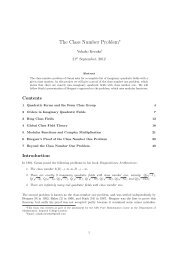
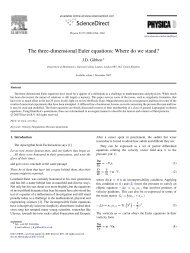
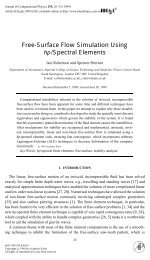
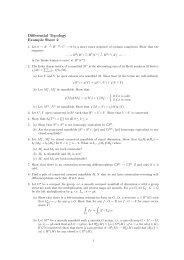

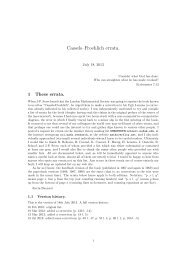

![Time Series (S8) 2012/2013 Coursework I: SOLUTIONS [1] (a) cov ...](https://img.yumpu.com/46239625/1/184x260/time-series-s8-2012-2013-coursework-i-solutions-1-a-cov-.jpg?quality=85)

